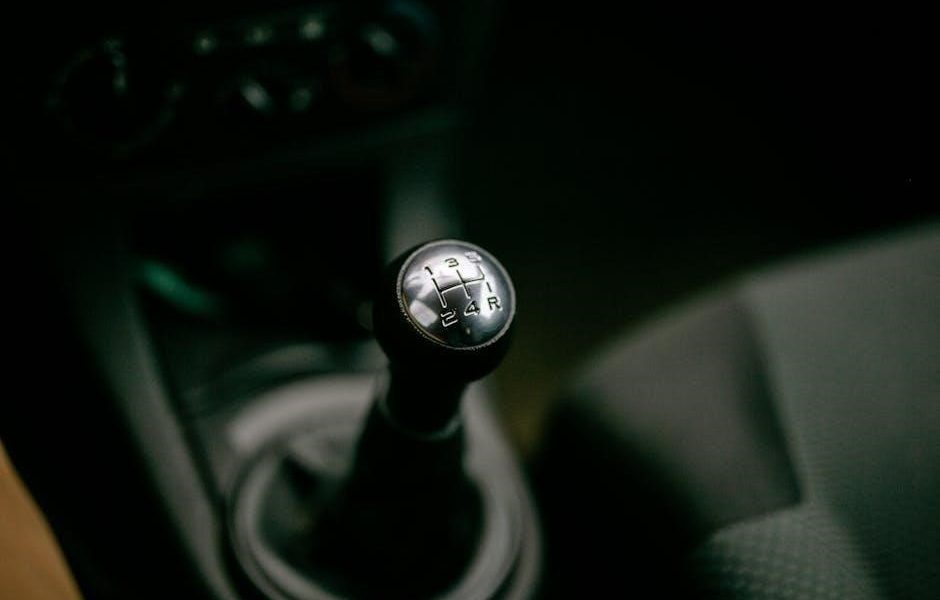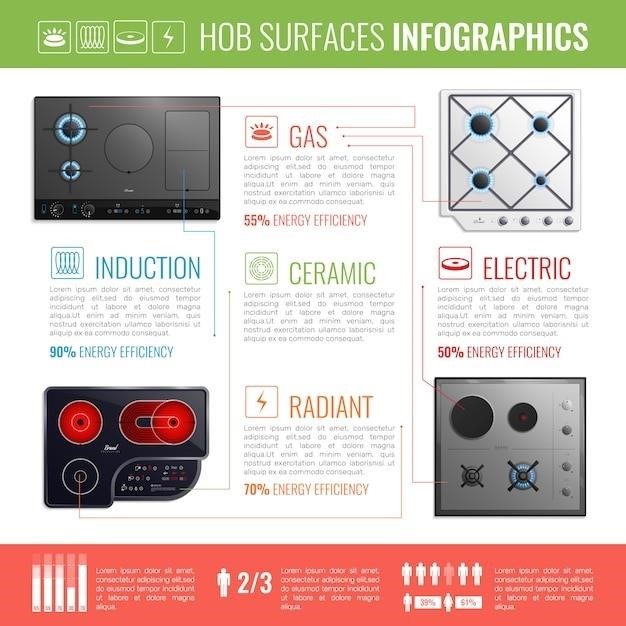Torque converters and manual gearboxes are distinct drivetrain components. A torque converter enables smooth power transfer in automatics, while a manual gearbox relies on clutch engagement for gear shifts. Exploring their integration reveals unique benefits and challenges, blending automatic smoothness with manual control, though technical limitations persist.
What is a Torque Converter?
A torque converter is a fluid-powered device that transfers power from an engine to a transmission. It uses fluid coupling to multiply torque at low speeds, enabling smooth acceleration from a standstill. Unlike a manual gearbox, which relies on a clutch, the torque converter allows the engine to remain disengaged from the transmission while idling. This eliminates the need for constant clutch engagement, providing seamless power delivery in automatic transmissions. Its design includes a pump, turbine, and stator, working together to optimize torque transfer and enhance drivetrain efficiency.
Role of a Torque Converter in Automatic Transmissions
A torque converter plays a vital role in automatic transmissions by enabling smooth power transfer between the engine and gearbox. It acts as a fluid coupling, allowing the engine to disconnect from the transmission while idling. This eliminates the need for manual clutch engagement, providing seamless acceleration and shifting. The torque converter also multiplies torque at low speeds, enhancing responsiveness, and absorbs driveline shocks, ensuring smoother operation. Its ability to progressively engage the transmission makes it indispensable for automatics, delivering a refined and effortless driving experience.
Overview of Manual Gearboxes and Their Mechanism
Manual gearboxes rely on driver input to select gears, using a clutch to disconnect engine power during shifts. The mechanism involves a clutch pedal, gear sets, and a shift fork system. When the clutch is pressed, it disengages the engine from the transmission, allowing manual selection of gears via the shifter. This setup provides direct control over power transfer and gear ratios, enabling precise acceleration and deceleration. Unlike automatics, manual transmissions lack torque multiplication, requiring drivers to actively manage gear changes for optimal performance.
Feasibility of Using a Torque Converter with a Manual Gearbox
Using a torque converter with a manual gearbox is possible but presents challenges. It can enhance smoothness and reduce vibrations but may limit gear shifting without stopping or clutch engagement.
Can a Torque Converter be Coupled to a Manual Transmission?
Coupling a torque converter to a manual transmission is unconventional but feasible in specific applications. It allows for smoother gear changes and reduced vibrations, particularly at low speeds. However, the torque converter does not fully disconnect the drive, requiring the vehicle to stop or use the clutch for shifting. This setup is beneficial in scenarios like heavy-duty machinery or racing, where torque multiplication and smooth power delivery are crucial. Despite its advantages, it introduces complexities such as stall speed limitations and the need for manual clutch engagement in certain conditions.
Historical Context and Development
The concept of integrating torque converters with manual gearboxes emerged during the early development of automatic transmissions in the mid-20th century. Initially explored to combine the smoothness of automatics with manual control, this idea was largely experimental. Historical records show limited production applications, as the complexity and weight of such systems often outweighed their benefits. However, niche markets, such as racing and heavy-duty machinery, embraced this hybrid approach for its unique performance advantages. Despite its potential, widespread adoption remained elusive due to technical and practical limitations.
Modern Applications and Innovations
Modern advancements have rekindled interest in torque converters for manual gearboxes, particularly in high-performance and niche applications. Companies like Weddle Industries offer specialized torque converter kits for racing transaxles, enhancing low-speed torque multiplication and smooth shifting. Additionally, some OEMs, such as Peugeot with their EAT6 gearbox, have explored hybrid systems combining torque converter smoothness with manual control. These innovations address historical limitations, offering improved drivability and performance in extreme conditions, though widespread adoption remains limited due to complexity and cost.

Benefits of a Torque Converter on a Manual Gearbox
Torque converters enhance manual gearboxes by improving smoothness and reducing vibrations. They enable clutch-less shifting and provide torque multiplication, boosting low-speed performance and drivability in various conditions.
Torque Multiplication and Improved Low-Speed Performance
A torque converter enhances low-speed performance by multiplying torque, allowing smoother acceleration from a standstill. This is particularly beneficial in heavy-duty applications or when navigating steep inclines. The fluid coupling within the converter absorbs engine vibrations, reducing jerky movements during gear shifts. However, below the converter’s stall speed, torque delivery diminishes, requiring careful throttle control. This feature is especially advantageous in scenarios like loader work, where precise, gradual power application is crucial. The result is improved drivability and reduced operator fatigue in demanding conditions.
Enhanced Smoothness and Reduced Vibrations
A torque converter significantly enhances smoothness by absorbing drivetrain shocks and vibrations through its fluid coupling. This reduces jerky gear changes, creating a more refined driving experience. The converter acts as a buffer between the engine and gearbox, minimizing abrupt power delivery. This feature is particularly beneficial in heavy-duty applications, where smooth operation reduces operator fatigue. Additionally, the converter’s ability to dampen vibrations improves overall drivetrain harmony, making it ideal for scenarios requiring precise control and comfort, such as loader work or low-speed maneuvering in industrial machinery.
Ability to Shift Without Clutch Engagement

A torque converter enables clutchless shifting in manual gearboxes by maintaining power delivery during gear changes. This eliminates the need for manual clutch engagement, simplifying operation. However, the system requires the vehicle to come to a complete stop before shifting, as the torque converter cannot disconnect the drive entirely. This feature is particularly useful in applications like heavy machinery, where frequent stopping and starting occur, enhancing convenience and reducing operator effort. Despite this advantage, the inability to shift on the move remains a limitation, balancing practicality with operational constraints.
Challenges and Limitations
Using a torque converter with a manual gearbox faces challenges like stall speed issues, clutch dependency for shifting, and added weight and complexity to the system.
Stall Speed and Torque Delivery Issues

A torque converter’s effectiveness is limited by its stall speed, below which it delivers minimal torque, causing sluggish performance at low speeds. This makes shifting gears challenging, as the converter fails to disengage properly, requiring manual clutch intervention. In stop-and-go traffic or when reversing, the lack of torque below stall speed hampers smooth operation. While the converter enhances smoothness, its inability to deliver torque at low speeds creates significant operational limitations, particularly in scenarios requiring precise control and quick acceleration.
Clutch Dependency and Gear Shifting Limitations
The torque converter’s inability to disconnect the drive means minimal torque is delivered below its stall speed, complicating gear shifts. Shifting without stopping becomes difficult, requiring manual clutch engagement. This creates a paradox where the clutch remains essential, even with the converter. The result is a system that offers some smoothness but retains the manual intervention typically associated with traditional gearboxes, limiting the converter’s ability to fully replace the clutch in a manual setup.
Weight and Complexity Additions
Integrating a torque converter into a manual gearbox adds significant weight and complexity. The converter introduces additional components like the pump, turbine, and stator, along with fluid, increasing overall mass. This added weight can negatively impact power-to-weight ratios, particularly in performance-oriented vehicles. The system also becomes more intricate, requiring precise engineering to ensure compatibility and functionality. Maintenance becomes more involved, as the torque converter adds another layer of potential failure points. This trade-off often deters enthusiasts seeking simplicity and efficiency in their manual transmissions.

Design and Functionality
A torque converter in a manual gearbox uses fluid coupling to transfer power, integrating with existing components while requiring custom engineering for compatibility and smooth operation.
Fluid Coupling and Its Role
Fluid coupling in a torque converter facilitates smooth power transfer between the engine and gearbox. It absorbs driveline shocks and vibrations, enabling seamless gear transitions. By allowing the engine to continue running without direct mechanical connection, it enhances low-speed maneuverability and torque multiplication. This feature is particularly beneficial for applications requiring frequent stops or heavy-duty operations. However, the fluid coupling adds weight and complexity, requiring careful integration with manual transmission components to maintain optimal performance and control.
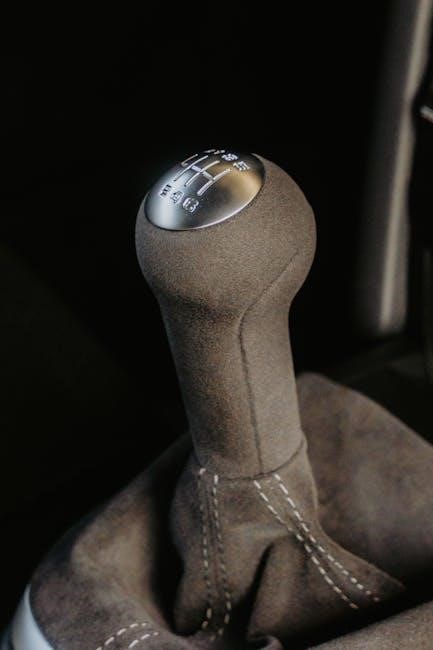
Integration with Manual Transmission Components
Integrating a torque converter with a manual gearbox requires precise mechanical and hydraulic connections. The torque converter replaces the traditional clutch, linking the engine to the transmission. Custom adapters and housings are often needed to mate the converter with the manual gearbox. This setup allows for smoother shifting and reduced driveline shock. However, it introduces complexity, as the converter must harmonize with the gearbox’s gear engagement mechanism. While it enhances low-speed operation, challenges like stall speed and torque delivery must be addressed for seamless functionality.
Custom Solutions and Aftermarket Kits
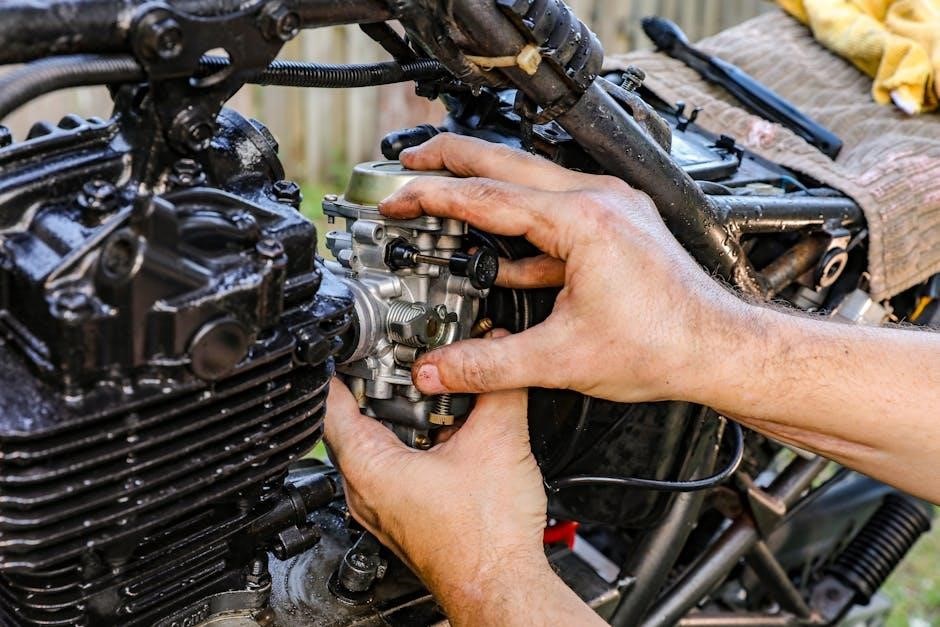
Custom solutions and aftermarket kits enable the installation of torque converters on manual gearboxes, catering to specific performance needs. Companies like Weddle Industries offer specialized torque converter kits designed for extreme applications, such as racing or heavy-duty use. These kits often include adapters and modified housings to integrate the converter with the manual transmission. While they enhance performance, installation requires mechanical expertise and may involve trade-offs, such as reduced simplicity or added complexity in shifting. Aftermarket kits bridge the gap between automatic smoothness and manual control, offering unique advantages for niche applications.

Installation and Maintenance
Installing a torque converter on a manual gearbox requires mechanical expertise and specialized tools. Regular fluid checks and maintenance ensure optimal performance and prevent wear. Troubleshooting common issues early is crucial for longevity.
Installation Process and Requirements
Installing a torque converter on a manual gearbox requires specialized tools and mechanical expertise. Custom adapters and precise alignment ensure proper fluid coupling and torque transfer. Electrical connections for sensors and solenoids must be integrated seamlessly. The process demands careful calibration to synchronize engine and gearbox operation. Manufacturer guidelines should be strictly followed to avoid damage. Regular maintenance, including fluid checks, is essential to maintain performance and prevent wear. Professional installation is often recommended due to the complexity of the setup.
Maintenance Tips and Service Intervals
Regular fluid checks and replacements are crucial for optimal torque converter performance. Inspect the cooling system to prevent overheating, which can degrade the converter’s efficiency. Monitor stall speed and torque delivery for signs of wear or imbalance. Check for leaks around the torque converter and transmission connections. Follow manufacturer-recommended service intervals for fluid changes and component inspections. Address any vibrations or unusual noises promptly to avoid damage. Professional servicing is advised for complex setups to ensure longevity and reliability.
Troubleshooting Common Issues
Common issues with torque converters on manual gearboxes include slipping, overheating, and vibration. Slipping often results from low fluid levels or worn clutch packs. Overheating can occur due to excessive load or poor cooling. Vibrations may indicate misalignment or imbalance. Monitor stall speed and torque delivery for inconsistencies. Address leaks promptly to prevent fluid contamination. If shifting becomes erratic, inspect the clutch and pressure plate for wear. Professional servicing is recommended for complex diagnostics and repairs to ensure optimal performance and reliability.
Real-World Applications
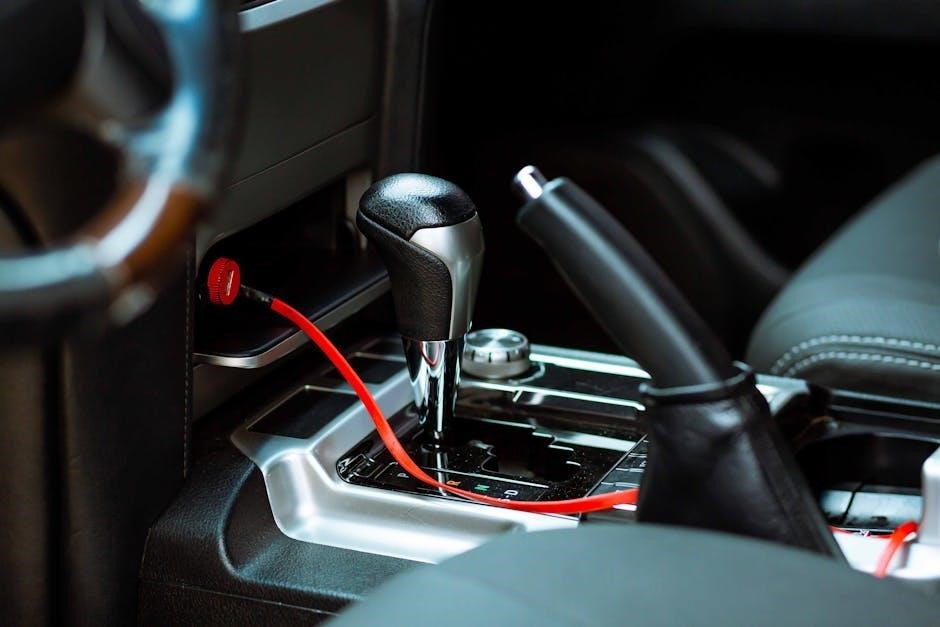
Torque converters on manual gearboxes are used in racing for smooth power delivery, heavy-duty machinery for consistent torque output, and specialized applications requiring precise control and efficiency.
Racing and High-Performance Vehicles
In racing, torque converters on manual gearboxes offer smooth power delivery and reduced mechanical inefficiencies. They minimize power loss during shifts, enhancing acceleration and stability. The fluid coupling absorbs engine vibrations, providing consistent torque output. This setup is ideal for high-performance vehicles requiring precise control and rapid gear changes. Some racing applications use torque converters to maintain engine speed between shifts, optimizing power delivery. However, the added weight and complexity can be a trade-off for the performance benefits they provide in competitive environments.
Heavy-Duty and Industrial Machinery
Torque converters on manual gearboxes are increasingly used in heavy-duty and industrial machinery for their ability to handle extreme loads and provide smooth power delivery. In construction equipment and industrial vehicles, torque converters reduce wear on the gearbox and clutch by absorbing driveline shocks. They enable seamless low-speed operation, crucial for tasks like loader work, where frequent stops and starts are common. This setup enhances efficiency and reduces operator fatigue, making it ideal for demanding industrial applications requiring consistent torque output and reliability.
Specialized Use Cases and Niche Markets
Torque converters on manual gearboxes find niche applications in extreme conditions, such as high-performance racing and unique industrial tasks. They provide torque multiplication and smooth power delivery, ideal for scenarios requiring precise control and reduced driveline shock. Custom solutions cater to specific industries, enabling operations like loader work or heavy-duty hauling. These setups are tailored for applications where traditional transmissions fall short, offering a blend of automatic smoothness and manual precision, making them invaluable in specialized markets where versatility and performance are critical.
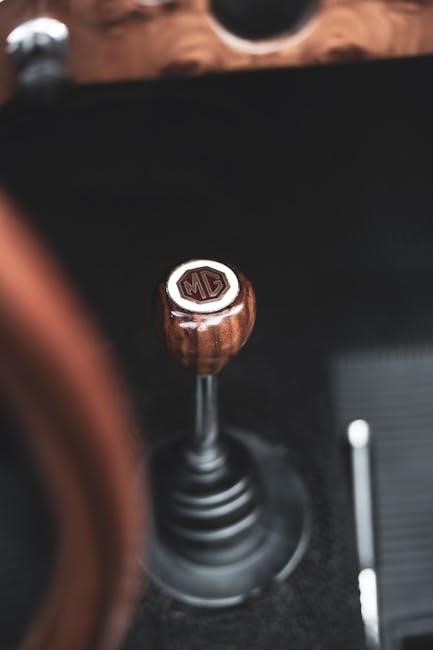
Future of Torque Converters in Manual Gearboxes
Advancements in technology and design are driving the integration of torque converters with manual gearboxes, offering enhanced performance and efficiency. Market trends suggest growing interest in hybrid solutions, blending automatic smoothness with manual control, potentially leading to widespread adoption in high-performance and specialized applications.
Advancements in Technology and Design
Modern torque converters for manual gearboxes feature improved fluid coupling efficiency and adaptive lock-up mechanisms, reducing power loss and enhancing smoothness. Design innovations include optimized stator designs and intelligent control systems, enabling better integration with manual transmissions; These advancements address historical limitations, such as stall speed issues, by providing more precise torque delivery. Custom solutions and aftermarket kits now offer tailored performance for specific applications, from racing to heavy-duty machinery, making torque converters a viable option for manual gearbox enthusiasts seeking improved drivability and efficiency.
Market Trends and Consumer Demand
The integration of torque converters with manual gearboxes is gaining traction, driven by demand for smoother, clutch-free shifting in high-performance and racing applications. Consumers increasingly seek the control of manuals with the convenience of automatics, prompting manufacturers to innovate. Dual-clutch transmissions and continuously variable systems are alternatives, but torque converters offer unique benefits. As technology advances, the market is shifting toward hybrid solutions, balancing performance and drivability. This trend reflects a growing preference for efficient, versatile drivetrains that cater to both enthusiasts and practical users, making torque converters in manuals a promising niche.
Potential for Widespread Adoption
While torque converters in manual gearboxes show promise, widespread adoption faces hurdles. Their added weight and complexity may limit appeal for mainstream vehicles, but niche markets like racing or heavy-duty machinery could embrace them. The ability to shift without clutch engagement and improved smoothness at low speeds are attractive, yet challenges like stall speed issues persist. As technology evolves, these systems might become more refined, but for now, they remain a specialized solution rather than a mainstream shift in drivetrain design.
Torque converters on manual gearboxes offer intriguing potential but face practical challenges. While they enhance smoothness and low-speed performance, their added complexity and weight limit widespread adoption.
Torque converters on manual gearboxes offer improved smoothness and low-speed performance but face challenges like stall speed limitations and clutch dependency. They enhance drivability in specific scenarios but add complexity and weight, limiting widespread adoption. While innovative solutions exist for niche applications, traditional manual transmissions remain more practical for most drivers due to their simplicity and efficiency.
Final Thoughts on Torque Converters and Manual Gearboxes
Torque converters on manual gearboxes present a unique blend of smoothness and control, offering benefits like reduced vibrations and improved low-speed performance. However, their integration introduces challenges such as added weight and complexity. While they enhance drivability in niche applications, traditional manual transmissions remain more practical for everyday use due to their simplicity and efficiency. The future may hold advancements, but for now, torque converters on manual gearboxes are best suited for specialized scenarios rather than widespread adoption.
